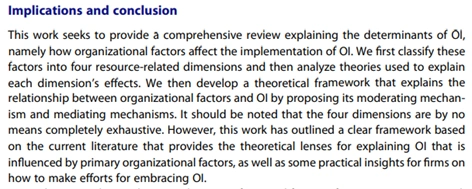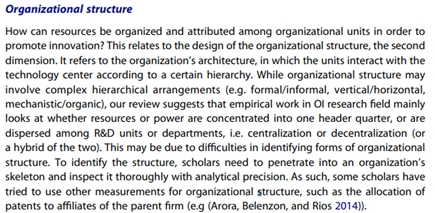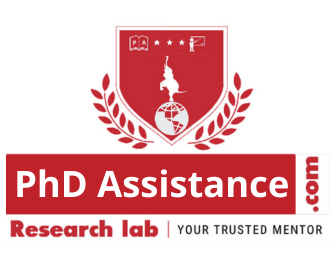Future Research Directions on Organizational Determinants of Open Innovation (OI)
Introduction
Open Innovation (OI) has become a crucial strategy for organizations to improve their competitive standing, share knowledge, and foster technological innovation. Organizational factors such as resource investment, organizational structure, human capital, and individual attitudes are key in determining how OI is adopted and sustained within organizations.
However, there is a vast body of literature on OI, the gaps in the literature include how these organizational factors develop, work in conjunction with, and affect innovation outcomes over time.
This article offers potential future research directions for doctoral students and researchers based on the current literature. Each section outlines the background, key research questions, potential hypotheses, implications, and suggested readings to help advance scholarly work in this area.
1. The Evolution of Resource Investment in Open Innovation
Background
Open Innovation (OI) has become a crucial strategy for organizations to improve their competitive standing, share knowledge, and foster technological innovation. Organizational factors such as resource investment, organizational structure, human capital, and individual attitudes are key in determining how OI is adopted and sustained within organizations [1]. Hence, more research into how resources influence OI can provide additional insights.

Source: https://www.tandfonline.com/doi/pdf/10.1080/14765284.2023.2210014?needAccess=true&role=button
Research Questions
- How does resource investment affect OI over time?
- What role does resource dependence play in OI implementation?
- How do firms optimize resource allocation at different stages of OI adoption?
Potential Hypotheses
H1: Organizations that dynamically adjust their resource investment strategies will demonstrate higher OI performance than those with static investment approaches.
H2: The interaction between internal and external resource investments positively influences OI sustainability.
Implications
However, whilst there is a vast body of literature on OI, the gaps in the literature include how these organizational factors develop, work in conjunction with, and affect innovation outcomes over time.
Suggested Readings
Barney, J. 1991. “Firm Resources and Sustained Competitive Advantage.” Journal of Management 17 (1): 99–120. doi:10.1177/014920639101700108.
Chesbrough, H. 2003. “The Logic of Open Innovation: Managing Intellectual Property.” California Management Review 45 (3): 33–58. doi:10.2307/41166175.
Pisano, G. P. 1990. “The R&D Boundaries of the Firm: An Empirical Analysis.” Administrative Science Quarterly 35 (1): 153–176. doi:10.2307/2393554.
2. The Role of Organizational Structure in Open Innovation
Background
Organizational structure dictates how organizations allocate resources, coordinate innovation efforts, and integrate external knowledge. Existing studies suggest that organizations may adopt centralized, decentralized, or hybrid structures for OI, but little is known about how these structures coexist or evolve over time [1].

Source: https://www.tandfonline.com/doi/pdf/10.1080/14765284.2023.2210014?needAccess=true&role=button
Research Questions
- What is the effect of co-existing structures (e.g., centralized and decentralized) on OI?
- How do organizations adapt their organizational structure to overcome internal inertia and align with external OI opportunities?
Potential Hypotheses
H1: Organizations that implement hybrid structures balancing centralization and decentralization achieve greater OI success than organizations with rigid structures.
H2: The ability to shift between organizational structures over time enhances OI adoption.
Implications
The findings of this research can be used to help organizations design adaptive organizational structures that can enable internal innovation and external collaboration.
Suggested Readings
Burns, T., & Stalker, G. M. (1961). Mechanistic and organic systems. London: Tavistock Publications.
Felin, T., & Zenger, T. R. (2014). Closed or open innovation? Problem solving and the governance choice. Research policy, 43(5), 914-925.
3. Human Capital and Leadership in Open Innovation
Background
The role of leadership and human capital in OI remains underexplored. On the one hand, the CEO’s vision and decision-making power set the OI strategy. On the other hand, the CTO and TMT shape innovation processes and external collaborations. There is virtually no research on how leadership dynamics and human capital mobility affect OI outcomes [1].

Source: https://www.tandfonline.com/doi/pdf/10.1080/14765284.2023.2210014?needAccess=true&role=button
Research Questions
- What is the effect of CEO-CTO relationships and conflicts on OI?
- How do TMT’s external relationships (e.g., managerial ties, industry networks) shape OI adoption?
- What is the impact of employee mobility (generalists vs. specialists) on OI performance?
Potential Hypotheses
H1: Organizations with stronger CEO-CTO collaboration experience higher OI adoption rates than organizations with leadership conflicts.
H2: Organizations that engage in cross-industry managerial networks achieve better OI outcomes.
Implications
This research can give insights into how leadership styles and human capital strategies affect OI effectiveness, which organizations can use to improve their talent search and keep and nurture future innovators.
Suggested Readings
Hambrick, D. C., & Mason, P. A. (1984). Upper echelons: The organization as a reflection of its top managers. Academy of management review, 9(2), 193-206.
Subramaniam, M., & Youndt, M. A. (2005). The influence of intellectual capital on the types of innovative capabilities. Academy of Management journal, 48(3), 450-463.
4. Individual Attitudes Toward Open Innovation
Background
Organizations’ attitudes towards OI such as Not-Invented-Here (NIH) and Not-Sold-Here (NSH) syndromes are likely either to help or hinder OI adoption. However, only very few studies have investigated how these attitudes develop at different stages of OI and how organizations can alter employees’ perceptions [1].

Source: https://www.tandfonline.com/doi/pdf/10.1080/14765284.2023.2210014?needAccess=true&role=button
Research Questions
- How can organizations tackle the NIH and NSH attitudes in order to enable OI?
- How does the employee attitude change at different stages of OI process implementation?
Potential Hypotheses
H1: Organizations that embrace a culture of OI suppress the tendencies of resistance to innovation over time.
H2: The involvement of employees in external innovation partnerships enhances their perception of OI.
Implications
Knowing the processes that can change employees’ perceptions towards OI may help organizations develop proper training programs, incentive systems, and communication plans.
Suggested Readings
Antons, D., & Piller, F. T. (2015). Opening the black box of “Not Invented Here”: Attitudes, decision biases, and behavioral consequences. Academy of Management Perspectives, 29(2), 193–217. https://doi.org/10.5465/amp.2013.0091
Chesbrough, H. (2003). The logic of open innovation: Managing intellectual property. California Management Review, 45(3), 33–58. https://doi.org/10.2307/41166175
Research Topic 5. The Interaction Effects of Organizational Factors in Open Innovation
Background
Current research typically examines resource investment, structure, human capital, and individual attitudes in isolation. However, these factors are interrelated and require a study that investigates how these dimensions are interconnected in the context of OI strategies [1].

Source: https://www.tandfonline.com/doi/pdf/10.1080/14765284.2023.2210014?needAccess=true&role=button
Research Questions
- What is the interaction effect of resource investment, structure, human capital, and attitudes on OI?
- In what circumstances can certain organizational factors increase or decrease the effects of the other on OI?
Potential Hypotheses
H1: Higher resource commitment, organizational flexibility, and enabling leadership enhance OI effectiveness.
H2: Employees’ attitudes towards OI act as a mediator between organizational structure and innovation outcome.
Implications
This research can be useful for organizations to refine their OI strategies as it reveals how various organizational factors can build on or offset one another.
Suggested Readings
Bogers, M., Chesbrough, H., & Moedas, C. (2017). Open innovation: Research, practices, and policies. California Management Review, 60(2), 5–16. https://doi.org/10.1177/0008125617745086
Laursen, K., & Salter, A. (2006). Open for innovation: The role of openness in explaining innovation performance among UK manufacturing firms. Strategic Management Journal, 27(2), 131–150. https://doi.org/10.1002/smj.507
West, J., & Bogers, M. (2014). Leveraging external sources of innovation: A review of research on open innovation. Journal of Product Innovation Management, 31(4), 814–831. https://doi.org/10.1111/jpim.12125
Conclusion
The study of organizational determinants of OI keeps being a rich and evolving field with numerous unanswered questions. The proposed research directions outlined in this article can offer new opportunities for doctoral students and scholars to contribute to OI literature.
- Studying resource evolution can enhance OI investment strategies.
- Innovative organizational structures can enhance the adoption of innovations.
- Leadership and human capital dynamics are determinants of OI success.
- Employee attitudes are important in the maintenance of external collaborations.
- There are more complex interrelationships among organizational factors that need further examination.
In answering these gaps, future work may contribute to the improvement of organizations’ OI strategies, so they can better navigate the digital economy.
Topic Selection Services by PhD Assistance
While the most crucial step in the long academic journey is the selection of the right PhD topic, this can be overwhelming at times. PhD Assistance understands such complexities.
We help you sort out your ideas, and emerging trends, and find an original research topic that reflects your interests and ambitions. Our team offers you personalized guidance, and you can thus feel confident making your choice and setting your path toward success.
Contact us today and let PhD Assistance help you start your PhD journey with confidence.

